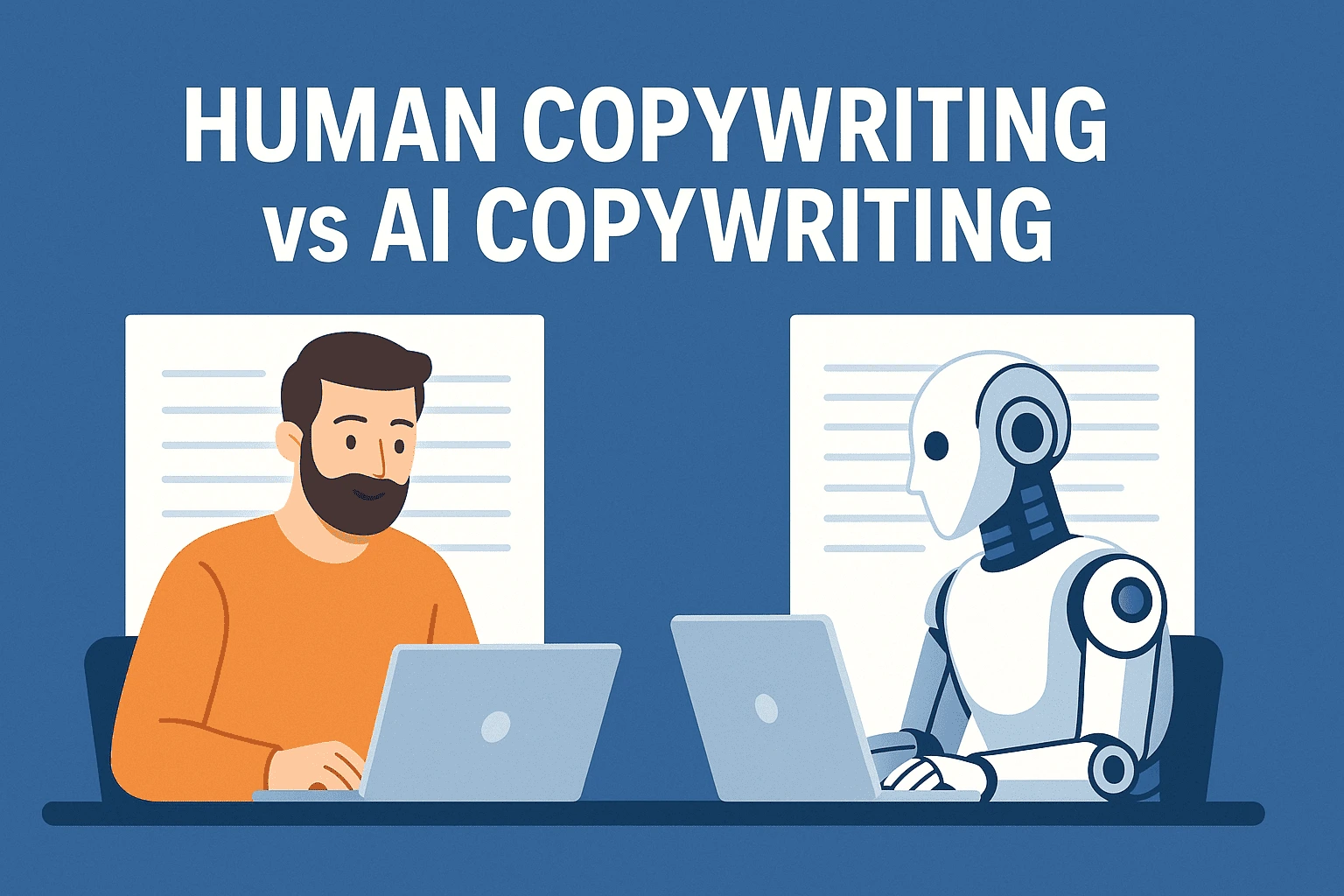
Copywriting has changed. Not long ago, all content came from human minds.
Now, AI tools can create blog posts, product descriptions, emails, and even ads in seconds.
But does that mean humans are no longer needed?
Not really.
In this article, we’ll look at how human copywriting compares to AI copywriting.
We’ll explore what each does well, where they fall short, and how to choose the right option for your needs.
Human Copywriting vs AI Copywriting: Side-by-Side Comparison
Here’s a simple table comparing both across common content types.
Copywriting Comparison by Content Type
| Content Type | Human Copywriting | AI Copywriting | Best Use |
|---|---|---|---|
| Landing Pages | Emotion, connection, persuasive flow | Quick layout, needs fine-tuning | Human-led with AI draft |
| Email Campaigns | Personalized tone, brand voice | Rapid production, needs editing | Mix of both |
| Product Descriptions | Clear benefits, rich context | High volume, keyword-ready | AI first, human edits |
| Ad Copy (Facebook/Google) | Hook-driven, strategic targeting | Multiple variations instantly | AI for ideas, human final |
| Long Blog Posts | Originality, storytelling, depth | SEO-focused, structure-ready | Human for main, AI support |
| Video/Audio Scripts | Tone-rich, audience-aware | Stiff without editing | Human writing preferred |
| Technical Writing | User-focused, precise | Straightforward but needs review | Human with AI assistance |
| SEO Articles | Intent-driven, well-researched | Fast drafts with keyword suggestions | AI for speed, human polish |
| Brand Storytelling | Emotion, legacy, values | Basic framework, lacks nuance | Human-led |
| Social Media Posts | Trend-aware, personality-driven | Fast, consistent | Use both together |
Strengths of Human Copywriting
Human writers bring a lot to the table. Here’s what stands out:
1. Emotion and empathy
Humans can write with heart. They understand how people feel and what motivates them. This shows in content that connects.
2. Brand voice
Humans can match tone, rhythm, and language to fit a brand. AI often sounds neutral or too generic.
3. Strategy and intention
Human copywriters ask why. They build content around business goals, customer behavior, and campaign strategy.
4. Creativity
Humans use humor, irony, stories, and cultural references. These things don’t always work in AI writing.
Limitations of Human Copywriting
Even great writers have limits.
Writing takes time. Crafting content from scratch can take hours or days.
Human output costs more, especially for large-scale work.
It’s hard to write 100 product descriptions or 10 emails in one day.
Strengths of AI Copywriting
AI tools have improved a lot. They are useful in many cases:
1. Speed
AI tools generate a blog post outline or 50 ad variations in seconds.
2. Volume
AI is perfect when you need to create content at scale, like eCommerce listings or short emails.
3. Structure
AI follows structure. It ensures the right flow, headings, and formatting for blog posts or emails.
4. SEO support
Most tools suggest keywords and build around them. This saves time during SEO content creation.
Weaknesses of AI Copywriting
AI has limitations too.
It can’t feel. Content often lacks emotional depth.
It repeats patterns and phrases. This makes it sound robotic at times.
It may not fully understand your brand’s voice or message.
It can include wrong facts, especially in technical or niche content.
When to Use Human Copywriting
Choose human writers when:
- You’re writing about your brand story or mission.
- You need original, high-value blog posts.
- You want emotional copy that builds trust.
- You need a sales page that converts.
- You’re working on scripts, pitches, or investor decks.
When to Use AI Copywriting
Use AI tools when:
- You need quick drafts, outlines, or headlines.
- You’re creating high-volume content like product listings.
- You want to test different ad versions fast.
- You need help with SEO-friendly content.
- You’re short on time and need ideas.
Use Both: A Smarter Way to Work
Most teams today use both human and AI copywriting. That’s a smart move.
Here’s how the hybrid workflow looks:
Step-by-step process:
1. Use AI to generate an outline or draft.
2. Review and edit for facts, tone, and clarity.
3. Human rewrites important parts, adds voice, and checks flow.
4. Final review for brand fit and audience impact.
This approach saves time but keeps the quality high.
Real Example: Product Descriptions
AI Alone:
“This high-quality water bottle is perfect for fitness lovers. Made of stainless steel and easy to carry.”
With Human Editing:
“Stay refreshed on the move. This leak-proof stainless steel bottle fits snugly in your gym bag and keeps drinks cool for 12 hours.”
The second one sounds natural and benefit-driven. That’s the human touch.
Conclusion
AI copywriting is fast, scalable, and helpful. Human copywriting is personal, emotional, and strategic.
You don’t need to pick one over the other.
The smartest writers and brands today use both. AI is a tool, not a replacement. When used well, it can support creativity, not kill it.
So, keep writing. Let machines assist, not lead.
The voice of a human still matters the most.


